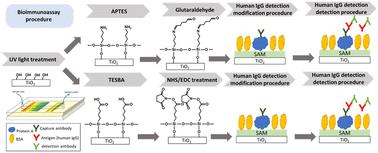Our official English website, www.x-mol.net, welcomes your
feedback! (Note: you will need to create a separate account there.)
4-(Triethoxysilyl)butanoic acid as a self-assembled monolayer for surface modification of titanium dioxide
Analyst ( IF 3.6 ) Pub Date : 2024-01-12 , DOI: 10.1039/d3an01795h Yu-Hsing Lai, Yan-Chang Lee, Hsun-Yuan Li, Wen-Hsin Hsieh
Analyst ( IF 3.6 ) Pub Date : 2024-01-12 , DOI: 10.1039/d3an01795h Yu-Hsing Lai, Yan-Chang Lee, Hsun-Yuan Li, Wen-Hsin Hsieh

|
In this study, the carboxy silane 4-(triethoxysilyl)butanoic acid (TESBA) was used to modify titanium dioxide (TiO2) to create a self-assembled monolayer (SAM) and then directionally immobilize a capture antibody using protein A. We selected the amino silane (3-aminopropyl)triethoxysilane (APTES) to perform a comparative analysis with TESBA, and employed glutaraldehyde (GA) as the control. The modification and detection effects and the limit of detection (LOD) were evaluated by detecting human immunoglobulin G (IgG). The average normalized sensitivity of the dual-grating coupler waveguide biosensor was 49.63 ± 0.27 RIU−1 and the optimum resolution was 1.30 × 10−6 RIU. When the SAM was prepared using TESBA and APTES followed by GA, the LOD was 4.59 × 10−7 g mL−1 and 5.29 × 10−7 g mL−1, respectively. We analyzed the modification and detection effects by the t-test and concluded that the differences in the modification effects using TESBA and APTES followed by GA were significant and the differences in the detection effects using TESBA and APTES followed by GA were insignificant. The use of TESBA as the SAM led to the modification effect being superior to that obtained using APTES followed by GA. The detection effect using TESBA was as outstanding as that using APTES followed by GA. Our findings demonstrate the feasibility and effectiveness of using TESBA as the SAM to carboxylate the surface of TiO2, thereby enabling immobilization of biomolecules for human IgG detection.
中文翻译:

4-(三乙氧基甲硅烷基)丁酸作为自组装单分子层用于二氧化钛表面改性
在本研究中,使用羧基硅烷 4-(三乙氧基甲硅烷基)丁酸 (TESBA) 修饰二氧化钛 (TiO 2 ) 以创建自组装单层 (SAM),然后使用蛋白 A 定向固定捕获抗体。我们选择采用氨基硅烷(3-氨基丙基)三乙氧基硅烷(APTES)与TESBA进行对比分析,并以戊二醛(GA)作为对照。通过检测人免疫球蛋白G(IgG)来评估修饰和检测效果以及检测限(LOD)。双光栅耦合器波导生物传感器的平均归一化灵敏度为49.63±0.27 RIU -1 ,最佳分辨率为1.30×10 -6 RIU。当使用TESBA和APTES然后使用GA制备SAM时,LOD分别为4.59 × 10 -7 g mL -1和5.29 × 10 -7 g mL -1 。通过t检验分析修饰和检测效果,得出TESBA和APTES加GA修饰效果差异显着,TESBA和APTES加GA检测效果差异不显着。使用TESBA作为SAM的修饰效果优于使用APTES然后使用GA获得的修饰效果。使用TESBA的检测效果与使用APTES然后使用GA的检测效果一样出色。 我们的研究结果证明了使用 TESBA 作为 SAM 来羧化 TiO 2表面的可行性和有效性,从而能够固定用于人类 IgG 检测的生物分子。
更新日期:2024-01-12
中文翻译:

4-(三乙氧基甲硅烷基)丁酸作为自组装单分子层用于二氧化钛表面改性
在本研究中,使用羧基硅烷 4-(三乙氧基甲硅烷基)丁酸 (TESBA) 修饰二氧化钛 (TiO 2 ) 以创建自组装单层 (SAM),然后使用蛋白 A 定向固定捕获抗体。我们选择采用氨基硅烷(3-氨基丙基)三乙氧基硅烷(APTES)与TESBA进行对比分析,并以戊二醛(GA)作为对照。通过检测人免疫球蛋白G(IgG)来评估修饰和检测效果以及检测限(LOD)。双光栅耦合器波导生物传感器的平均归一化灵敏度为49.63±0.27 RIU -1 ,最佳分辨率为1.30×10 -6 RIU。当使用TESBA和APTES然后使用GA制备SAM时,LOD分别为4.59 × 10 -7 g mL -1和5.29 × 10 -7 g mL -1 。通过t检验分析修饰和检测效果,得出TESBA和APTES加GA修饰效果差异显着,TESBA和APTES加GA检测效果差异不显着。使用TESBA作为SAM的修饰效果优于使用APTES然后使用GA获得的修饰效果。使用TESBA的检测效果与使用APTES然后使用GA的检测效果一样出色。 我们的研究结果证明了使用 TESBA 作为 SAM 来羧化 TiO 2表面的可行性和有效性,从而能够固定用于人类 IgG 检测的生物分子。






























 京公网安备 11010802027423号
京公网安备 11010802027423号